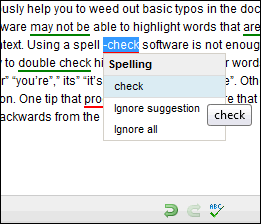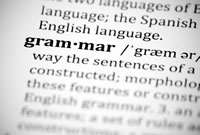
Spell checking takes time
When it comes to any type of writing, proof reading is considered as the last step in the editing process. Whether you are writing an article, a book, press release, email, or any other type of document it is important to understand that proofreading helps you to avoid embarrassing typos, spelling mistakes or confusing sentences. Proofreading can either be done on a hard copy material or on a computer using a spell checker; it all depends on an individual’s preference.
Importance of proofreading
Before an academic research paper, email, essay, book, memo or any type of document is printed or published, it must be proofread thoroughly. Proof reading involves reading a written document slowly and carefully so as to determine if the document communicates the message precisely. If the introductory paragraph or title does not bring out the intended meaning clearly, then it should be rewritten so as to flow naturally. The first part of proof reading involves editing the whole flow of the article, the second phase will usually involve deeper analysis where errors such as; word usage, spelling, grammar, punctuation are checked into detail. Proofreading ensures that a written document communicates the intended message effectively.
Before Proof reading is done 4 essential factors must be considered; here are four main factors that are taken into account.
Typos

Typos are embarrassing
This is usually the first step factor taken into account when proofreading. Typos are basically errors or mistakes made while typing or writing on a paper. Correcting typos or typing mistakes involves slowly reading the document word by word as opposed to reading quickly through the sentences. Words that contain few letters can be incorrectly switched or sentences incompletely written.
It’s therefore crucial that one should check out such mistakes. If you are using a computer to edit a document then it’s highly suggested that you zoom the article or document so as to pick out the errors easily.
Here’s an interesting list of common misspellings: http://en.wikipedia.org/wiki/Wikipedia:Lists_of_common_misspellings
Spelling

A spell checker can help
Using a computer will obviously help you to weed out basic typos in the document as well as most spelling mistakes. However, spell checker software may not be able to highlight words that are spelled correctly but are used inappropriately or are not used in the right context. Using a spell -check software is not enough when checking for spelling mistakes, one should additionally use a dictionary to double check his or her spelling. Other words to look out for when correcting spellings errors include words such as;”your” “you’re”,” its” “it’s”,”their”, “there”, “they’re”. Other spelling mistakes to check out include; incorrect capitalization and punctuation. One tip that proofreaders use to ensure that the correct spelling or all errors are weeded out is to read a given document backwards from the last word to the first.
Here’s a free online spell checker that works pretty good: http://www.spellcheckonline.com/
A cool infographic on common spelling errors: http://theoatmeal.com/comics/misspelling
Grammar

Grammar checking is essential
Grammatical error or mistakes can be corrected if you re-read a given document slowly. A grammar checker is an important tool that can help you to locate grammatical errors in a document, though relying on it fully will be an exercise in futility as the software may not be able to recognize all grammar mistakes. Therefore it’s essential that you check grammar mistakes using both manual and automated means. For instance you can look out for “run- on” sentences then ideally break them into two or add commas where necessary. You should also try to use conjunctions words like and “but”, “or”, “and” so as to make the sentences more readable and devoid of errors.
A document written with the correct grammar will consist of sentences with proper nouns and pronoun which are in agreement, will have the correct punctuation, will have parallel structure in “series” etc. Content should also be written in the correct or most appropriate tone e.g. friendly, professional or personal depending on the situation. A good Grammar check entails using both manual and automated methods to correct all possible grammatical mistakes.
Always make sure you’re up to date on the latest grammar rules: http://www.englishgrammar.org/rules/
A funny list of 10 grammar mistakes that could make you look stupid: http://www.zdnet.co.uk/news/it-strategy/2006/06/06/10-flagrant-grammar-mistakes-that-make-you-look-stupid-39273376/
To check your grammar online, this grammar check comes in handy: http://www.grammarcheck.net/
Inconsistency

Look out for contradictory statements.
Inconsistencies involves looking out for things such as; contradictory statements, grammatical person inconsistency, use of improper names, wrong fonts, wrong type size, incorrect spacing, not including page numbers, not labeling headers and footers etc. Checking for inconsistencies requires that you read the whole document slowly and carefully. You can ideally take a break if you are mentally exhausted as this will help you to refocus and as a result produce good or quality work.
Proofreading tips
If you intend on writing a magazine or ezine article, an email, college essay, web content, academic research paper or any other type of document , then here are several tips that you can use to enhance proofreading effectiveness.
Total concentration

Take your time!
Spotting all manner of errors or mistakes in a document requires your full concentration. For you to achieve total concentration it’s essential that you avoid unnecessary distractions or interruptions. Some of things you can do to increase you concentration include; turning off your TV, switching off your mobile phone, staying away from social media profiles such as Facebook or twitter, not opening email etc
Print it on paper

Weed out mistakes
Reading on a computer screen is different compared to reading on printed paper. Printing material on screen can help you weed out mistakes you probably did not see or recognize.
Use color marks to highlight errors on the print out: http://staff.tuhsd.k12.az.us/jsummers/Proofreading%20Marks.pdf
Look out for Homonyms
Homonyms are basically words that usually share the same pronunciations or spelling but posses different meanings. For example it easy to confuse words like “accept” with “except” or words like “complement” with “compliment”, any mixing of the terms can be disastrous. It’s therefore crucial to pay keen attention to such words.
Here’s a useful list of homonyms: http://www.cooper.com/alan/homonym_list.html
If you need further information, here’s the wikipedia article on homonyms: http://en.wikipedia.org/wiki/Homonym
Look out for apostrophes and contractions
It’s essential that you understand the use of apostrophes, for instance mixing terms like “their” and “they’re” can hurt the credibility of your document or text immensely.
Check punctuation and capitalization
It’s crucial that you put punctuation marks where they are required. Another tip is to ensure that your texts are correctly capitalized.
Here’s a good post that explains why grammar checking is so important: http://www.englishgrammar.org/check/
Proofread numbers
Make sure you pay attention to numbers only giving out the correct figures. Mistakes such as incorrect figures can be very embarrassing.
Let friends or colleagues proofread it again
After proofreading yourself its recommended that you let your friends proofread it again as they may be able to spot mistakes you could not see.
Thank you very much,all the information that you mentioned are very useful for all ,I liked this one(Importance of proofreading) I,ll share your post right now.I look forward to more posts soon.